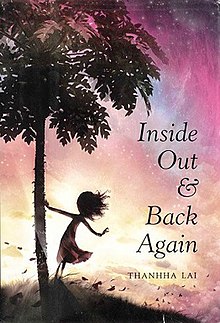Inside Out & Back Again
Inside Out & Back Again is a verse novel by Thanhha Lai.[1] The book was awarded the 2011 National Book Award for Young People's Literature[2] and one of the two Newbery Honors.[3] The novel was based on her first year in the United States, as a ten-year-old girl who spoke no English in 1975.
 | |
| Author | Thanhha Lai |
|---|---|
| Cover artist | Zdenko Bašić, Mauel Šumberac, Ray Shappell |
| Country | United States |
| Language | English |
| Genre | Historical Fiction |
| Published | September 22 2011 |
| Publisher | HarperCollins |
| Media type | Print (hardcover) |
| Pages | 260 |
| ISBN | 978-0-06-196278-3 |
| OCLC | 606403465 |
Plot summary
Inside Out and Back Again is a story about a young girl named Kim Hà and her family, consisting of her Mother and three brothers, being forced to move to the United States because the Vietnam War had reached their home, and it was no longer safe. They board a navy ship and flee. Upon spending a couple months at a refugee camp, they end up moving to Alabama. There Hà struggles with learning English and confronting bullies, including one that she nicknamed Pink Boy, at her new school. Hà at one point said, "No one would believe me but at times I would choose wartime in Saigon over peacetime in Alabama."[4] Eventually, she has pushed through those hard times with the help of their next door neighbor, Mrs. Washington and the support of her family. In the beginning of the book, it mentions that Hà's father, a soldier in the Vietnam war, was captured by the North Vietnamese Army when she was only a year old. In the end, Hà's family figures out that unfortunately, her father had died while in North Vietnamese hands. Hà then gets used to living in the U.S and her family celebrates the new year. She prays for good things to happen to her and her family.
Origin
Thanhha Lai had been struggling for fifteen years in order to accurately describe Hà's journey from Vietnam to the United States of America because Hà's journey was special—the fictional character was based on Lai’s own experience at the end of the Vietnam War. In order to avoid embellishing on her memory and risking the ire from the family who was there with her, Lai decided to tell the story of Hà instead. She attempted prose from the first person and the short, detached style of Hemingway. In the end, Lai used free verse because “these phrases reflected what Vietnamese sounded like.” [5]
Critical reception
Jennifer Rothschild described “Each passage is given a date so readers can easily follow the progression of time. Sensory language describing the rich smells and tastes of Vietnam draws readers in and contrasts with Hà's perceptions of bland American food, and the immediacy of the narrative will appeal to those who do not usually enjoy historical fiction.” Publishers Weekly claimed that “Lai gives insight into cultural and physical landscapes, as well as a finely honed portrait of Hà's family as they face difficult choices ... finally regains academic and social confidence. An incisive portrait of human resilience.”[6]
References
- "Thanhha Lai - About the Author". HarperCollins Publishers. Retrieved 1 March 2012.
- "2011 National Book Award Winner, Young People's Literature". National Book Foundation. Retrieved 1 March 2012.
- "2012 Honor Books". American Library Association. 1999-11-30. Retrieved 1 March 2012.
- "About the Book Inside Out and Back Again". HarperCollins Publishers. Retrieved 1 March 2012.
- Lai, Thanhha (2013). Inside Out & Back Again. New York: Harper Collins. ISBN 9780061962790.
- Reviews, Riverside Public Library